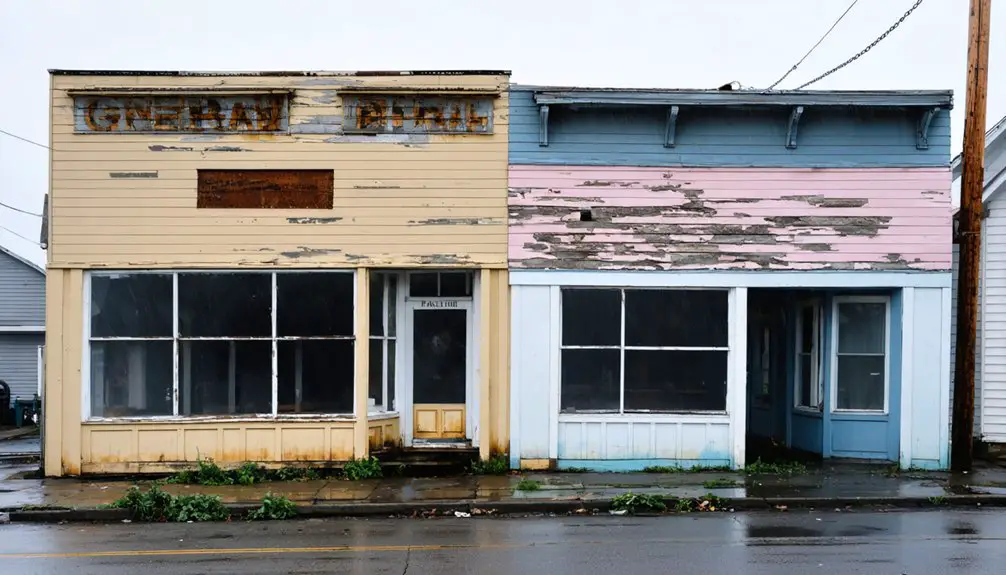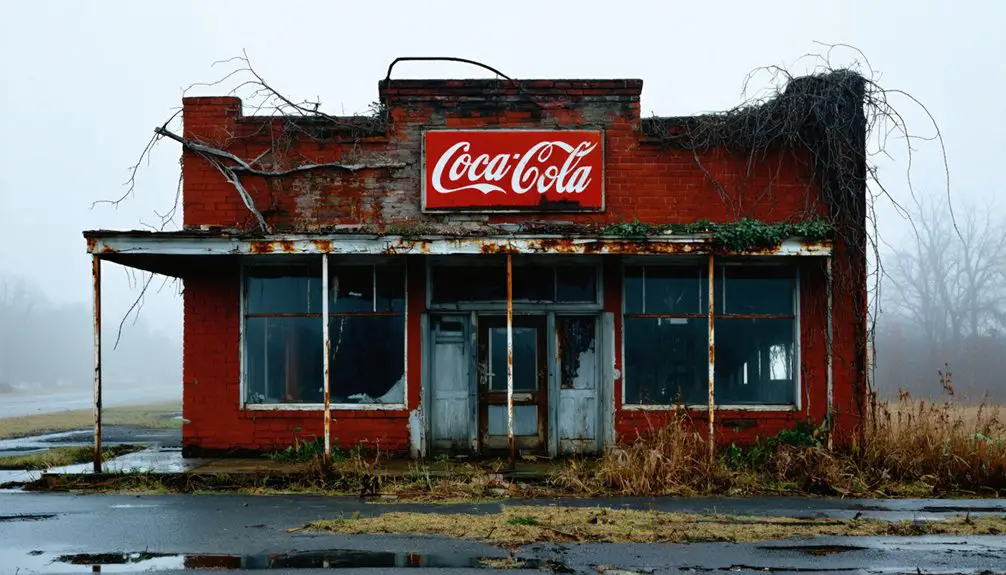You’ll find South Boardman not as a true ghost town, but rather a shadow town that still maintains traces of its vibrant past. Originally established in 1872, this Kalkaska County lumber town flourished with 400 residents, three mills, and a bustling business district until the Great Fire of 1923 devastated the community. While many businesses never rebuilt, century-old structures and converted commercial buildings tell the story of Michigan’s resource-dependent heritage.
Key Takeaways
- South Boardman transformed from a bustling lumber town into a shadow town after the devastating Great Fire of 1923.
- Many businesses never rebuilt after the 1923 fire, causing rapid economic decline and population loss from its peak of 400 residents.
- Former commercial buildings were converted to residential use, diminishing the town’s once-vibrant business district.
- The town is considered a “shadow town” rather than a ghost town, as some residents remain and historical structures still stand.
- South Boardman’s American Legion Post and museum preserve the town’s history as a former logging industry hub.
Early Settlement and Town Origins
While the logging industry drove much of northern Michigan’s development in the late 19th century, South Boardman emerged as a distinct settlement in 1872 within Kalkaska County’s Boardman Township.
Starting with just 25 residents, early pioneers like the Dagle family transformed dense forest into farmland, establishing the foundations of a growing community. The town’s prosperity was fueled by three lumber mills that provided employment and economic stability. Located at the junction of US-131 and Boardman, the town became a strategic transportation hub.
From dense wilderness to fertile fields, South Boardman’s earliest settlers carved out a future from Michigan’s untamed forest.
Settlement challenges included limited access to basic supplies, requiring 25-mile treks to Traverse City for groceries. Despite these obstacles, the town grew steadily, reaching 400 residents by 1918.
A diverse wave of immigrants, including Germans, Canadians, British, Norwegians, and Bohemians, established farms and contributed to the town’s development. They built essential structures including a flour mill, boarding house, two hotels, five saloons, and four churches, creating a vibrant social and economic hub in northern Michigan.
Boom Years of the Logging Era
South Boardman’s transformation from a modest settlement into a thriving lumber town began in earnest as Michigan’s timber industry boomed during the mid-19th century.
Early development accelerated when Hamilton Stone completed construction of the town’s first dam in 1877.
You’d have witnessed the local sawmill evolve from producing just 2,000 feet of lumber per day to an impressive 15,300 feet after upgrading to circular saws.
The town’s strategic location near both the railroad and South Branch of the Boardman River fueled its rapid economic growth.
Loggers would stack timber along the riverbanks in winter, then release them during spring thaws. This efficient combination of water and rail transport made South Boardman a crucial hub in Michigan’s lumber production network.
The boom years brought diversification too, with gristmills joining the industrial landscape and wood product factories employing hundreds of workers. In 1879, T. P. Shuerts established the town’s first gristmill, marking an important expansion beyond lumber production.
Community Life and Infrastructure
You’d find South Boardman’s community life centered around its four churches and five saloons, which served as crucial gathering spaces for both spiritual and social activities during the town’s peak years.
The post office and Legion Post near the railroad tracks provided essential services and meeting places for residents, creating hubs of daily interaction and communication. Similar to many ghost town communities, South Boardman’s remaining buildings now stand as silent reminders of its once-thriving social life.
While the town offered these social amenities, residents faced significant challenges in accessing basic necessities, having to travel 25 miles to Traverse City for grocery shopping. Just as the Methodist church in Central Mine served as a community focal point, South Boardman’s churches played a similar role in bringing residents together.
Social Gathering Spaces
Despite its modest size, South Boardman’s social fabric centered around an impressive variety of gathering spaces in the early 1900s.
In Kalkaska County’s historic district, residents regularly gathered to discuss local affairs and share stories.
You’d find five saloons bustling with informal gatherings, card games, and billiards, while four churches served as pillars of community events beyond just worship. The local boarding house and hotels created essential social dynamics between permanent residents and transient workers. Similar to the Slovak Home Temple in Detroit that later fell into disrepair, these gathering places were vital community anchors.
If you’d visited back then, you’d have seen how the Legion Post near the railroad tracks provided a dedicated space for veterans, while the post office functioned as a daily meeting point where locals exchanged news.
Though the town lacked formal parks or sports facilities, these diverse venues compensated by hosting social dinners, holiday celebrations, and informal entertainment – until the devastating 1923 fire destroyed much of the business district’s social infrastructure.
Essential Town Services
Four essential services anchored daily life in early South Boardman: postal operations, basic utilities, emergency response, and transportation infrastructure. The post office served as a crucial communication hub, maintaining connections with larger towns like Traverse City. You’ll find it’s still operating downtown today, preserving the town’s minimal viability.
Like Amik’s Fire Hall of 1911, early infrastructure reflected logging prosperity, with multiple mills, hotels, and churches supporting the community. However, the devastating 1923 fire exposed weaknesses in emergency services and forever altered the town’s trajectory.
While some old commercial buildings have been converted to homes, you can trace the town’s heritage through remaining railroad tracks and the Legion Post. Transportation access via US-131 and Boardman Road continues to sustain the area’s limited activity, though residents must travel significant distances for many essential services.
The Great Fire of 1923
In 1923, a catastrophic fire swept through South Boardman’s business district, destroying the town’s essential commercial establishments that had developed during its logging industry heyday.
You’ll find that most businesses chose not to rebuild after the devastation, marking a turning point in the town’s prosperity that had peaked around 1918 with a population of 400 residents.
The fire’s aftermath transformed South Boardman from a bustling lumber town into a near ghost town, with many former shops converted to residential use and only a few structures, including the post office and a Legion Post, remaining as evidence of its commercial past. The destruction was accelerated by strong northwest winds that quickly spread the flames throughout the area.
Devastating Impact on Commerce
When the Great Fire of 1923 swept through South Boardman, it obliterated the town’s entire business district, marking a devastating turning point in the community’s commercial history.
You’ll find that this catastrophic event destroyed essential commercial infrastructure, including the flour mill, hotels, lumber mills, post office, and saloons that had supported a thriving population of 400 residents by 1918.
The fire’s aftermath revealed South Boardman’s limited economic resilience, as residents who already had to travel 25 miles to Traverse City for groceries now faced even greater hardships.
The destruction of businesses at the significant junction of US-131 and Boardman Road crippled local commerce and transport logistics.
With no substantial rebuilding efforts following the disaster, South Boardman transformed from a bustling commercial hub into a shadow town, preserving its trading legacy only through historical records.
Community Response After Destruction
The devastating Great Fire of 1923 sparked an immediate and coordinated response from South Boardman’s resilient community.
You’ll find that local residents, lumber mill owners, and neighboring towns quickly banded together, demonstrating remarkable community resilience as they erected temporary shelters and distributed essential supplies to those displaced by the inferno.
In the wake of destruction, the town’s disaster preparedness evolved through decisive action.
Community leaders organized gatherings to assess damages and prioritize rebuilding efforts. The lumber industry swiftly resumed operations to provide construction materials, while property owners and workers cleared debris to prepare for new development.
Churches and boarding houses became crucial social anchors, boosting morale during the recovery phase.
Despite these united efforts, the fire’s aftermath ultimately accelerated South Boardman’s transformation into a smaller settlement.
Transformation Into a Shadow Town

South Boardman’s transformation from a bustling logging town into a shadow town began abruptly after a devastating 1923 fire destroyed its business district.
You would’ve seen rapid economic decline as shops, saloons, and lumber mills – once the heartbeat of this 400-person community – vanished in the flames. While some residents stayed behind, converting old commercial buildings into homes, the town’s bustling atmosphere disappeared.
The post-fire recovery efforts never gained momentum, leading to significant population loss. Unlike complete ghost towns, South Boardman retained a small community, with the American Legion Post and museum serving as reminders of its former glory.
While not abandoned like classic ghost towns, South Boardman lives on as a quiet shadow of its prosperous logging days.
Today, you’ll find a mix of historic architecture and newer homes, though the town’s commercial footprint has dramatically shrunk, marking its permanent shift to shadow town status.
Historical Legacy and Present Day
Today, exploring South Boardman reveals a fascinating blend of historical resilience and modern adaptation, where you’ll find century-old structures intermingled with newer homes along the quiet streets.
This former logging boomtown, located 25 miles southeast of Traverse City, stands as an evidence of Michigan’s resource-dependent past. While the devastating 1923 fire destroyed its business district, you can still witness the town’s historical significance through preserved landmarks like the Legion Post and local museum.
As a “shadow town” rather than a complete ghost town, South Boardman maintains its cultural memory through continued habitation and preserved heritage buildings.
You’ll discover converted storefronts that now serve as private residences, each telling a story of the community’s transformation from a bustling lumber town to a quiet residential enclave.
Frequently Asked Questions
Are Any Descendants of Original South Boardman Settlers Still Living There Today?
You won’t find documented descendant stories definitely linking current residents to original settlers, though family heritage connections might exist – available records don’t confirm any direct lineage to South Boardman’s founding families.
What Native American Tribes Originally Inhabited the South Boardman Area?
You’ll find the Ojibwe (Chippewa) were the primary native tribes in this area, with historical significance dating to the 1700s. The Odawa and Potawatomi, their Three Fires allies, also frequented the region.
Was South Boardman Ever Connected to Michigan’s Railroad System?
You wouldn’t believe how essential the railroad connections were! By the mid-1870s, you’d find South Boardman thriving with both passenger and logging rail lines that shaped the region’s transportation history.
Did South Boardman Have Its Own School System Historically?
You’ll find evidence of a well-established historic education system with its own local governance, including a documented principal in 1884 and certified teachers who maintained high academic standards through the mid-1900s.
What Was the Average Property Value During South Boardman’s Peak Years?
While exact records are scarce, you’d find property values during peak logging years (1900-1923) ranged from $200-$2,000 for homes and up to $5,000 for commercial properties in the bustling market.
References
- https://99wfmk.com/south-boardman-michigan/
- https://99wfmk.com/south-boardman-1900-2020s/
- https://kids.kiddle.co/List_of_ghost_towns_in_Michigan
- https://wjimam.com/south-boardman-2021/
- https://wkmi.com/ocqueoc-michigan/
- https://www.npshistory.com/publications/slbe/garden.pdf
- http://genealogytrails.com/mich/kalkaska/boardman.html
- https://genealogytrails.com/mich/kalkaska/citysouthboardman.html
- https://msaf.forest.mtu.edu/ForestInfo/MSUElibrary/LumberingInMichigan.PDF
- https://gtjournal.tadl.org/2017/transformations-of-boardman-lake-a-place-to-work-a-place-to-play-a-place-to-live/



